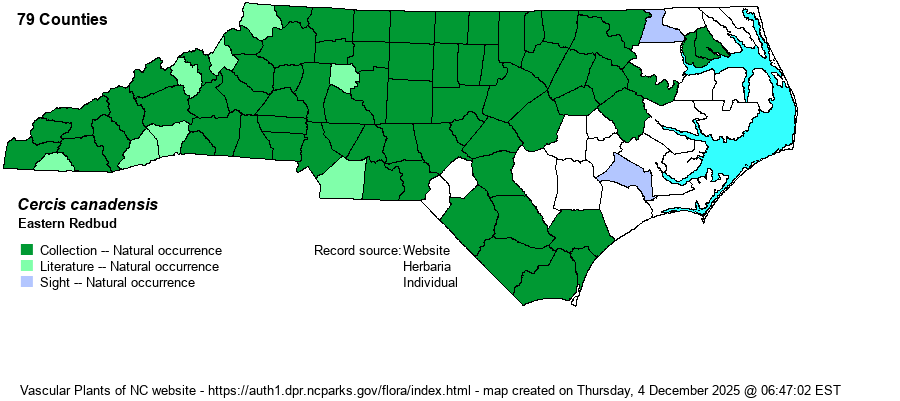| Author | L. | |
| Distribution | Throughout the Piedmont and essentially also the Mountains. Present across the western Coastal Plain (absent from the Sandhills proper) and found at scattered sites in the lower Coastal Plain, though seemingly absent on the Pamlimarle Peninsula and in the extreme northeastern corner. Note that iNaturalist contains photo records for most NC counties; however, as this is a commonly planted street and yard tree, such records in the Coastal Plain are not accepted for the range map.
This is a very widespread species, occurring from the Atlantic coast from CT to FL, and west to NE and NM. The range is spotty on the Delmarva Peninsula, as well as in eastern NC.
| |
| Abundance | Common and widespread in the Piedmont, and some low Mountains; rare to uncommon at best in the southwestern mountains and the northern mountains. Fairly common in parts of the upper Coastal Plain; also present (but scarce) in rich forests in the southeastern corner of the state. Absent to very rare in the Sandhills proper and in many far eastern counties. | |
| Habitat | This is a species of rich to mesic hardwood or mixed forests, especially characteristic of the understory in Mesic Mixed Hardwood Forest or Basic Mesic Forest natural communities. It is most numerous on circumneutral to somewhat basic soils. It may occur in drier forests, but then mostly where the soils have a high pH. In the mountains and Piedmont, the species is not as “finicky” about soil type, but closer to the coast is can only be found in rich, high pH soil. As it is often planted as an ornamental, occurrences in some areas, such as roadsides, might not be completely natural. |
| Phenology | Blooms from March into May, before or just as the leaves emerge. Fruits from June to November. | |
| Identification | This is one of the easiest plants in the state to identify, at least in the growing season. This is a small to rarely medium-sized deciduous tree, growing mostly to about 25-40 feet tall. The fairly large, heart-shaped leaves to about 4 inches long are essentially unique, at least among native trees. Also, the small clusters of bright rose to pink flowers and buds, growing closely along the stems, are visible before the leaves emerge, marking a tree as a Redbud at long distances, even from a speeding vehicle. | |
| Taxonomic Comments | The species is considered to have several varieties, over its wide range. The nominate variety – var. canadensis, is the only one in our area.
| |
| Other Common Name(s) | As there are several other species of Cercis around the globe, recent references typically add the “Eastern” to the Redbud common name. Of course, the usage of simply “Redbud” is suitable when referring to the tree in the Eastern United States. | |
| State Rank | S5 | |
| Global Rank | G5 | |
| State Status | | |
| US Status | | |
| USACE-agcp | UPL link |
| USACE-emp | FACU link |

